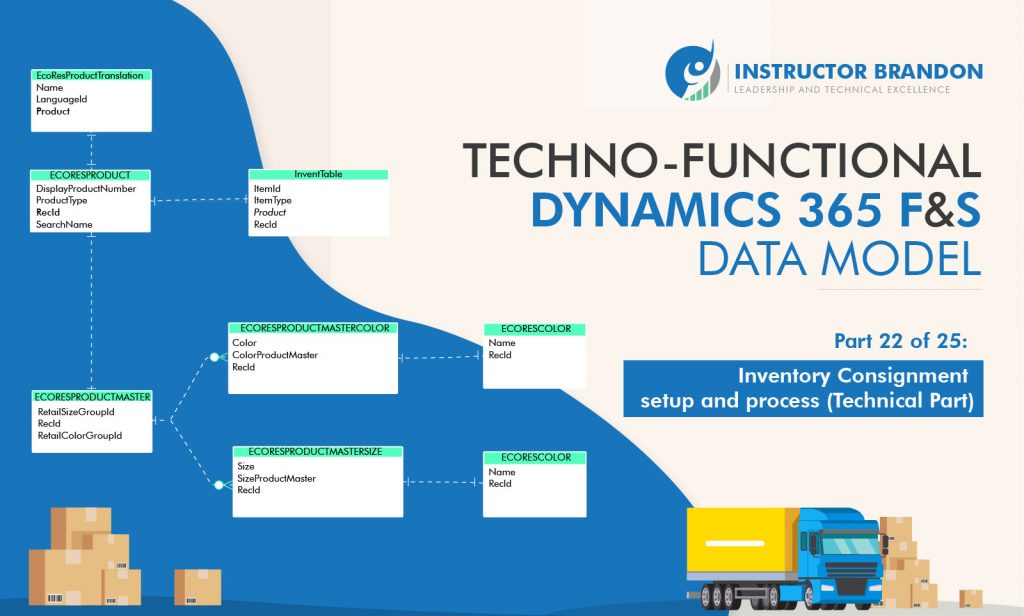Data Model Series, Dynamics 365 Tutorials
Techno-Functional Dynamics 365 Data Model Explanations for Reporting, Part 22 of 25: Understanding Inventory Consignment Process in Dynamics 365
Inventory Consignment Setup and Process in Microsoft Dynamics 365 [Technical]
‘Optimizing Inventory Consignment Process’ is the second part of Dynamics 365 Inventory Consignment Setup and Process. It is equally important to understand.
This blog consists of 3 sections:
- In the 1st section, we will be discussing the Entity Relationship Diagram and tables for creation of a released item in Dynamics 365. For Developers, X++ code is added to directly create a released item in Dynamics 365.
- Moving towards the 2nd section, we will discuss Entity Relationship Diagram (ERD) and table details to understand the Inventory Owner Creation Process in Dynamics 365.
- Lastly, in the 3rd section, Inventory Consignment Journal creation will be discussed.
For tables and the relationship between them in the Inventory Consignment Journal Creation Process, ERD and table details are mentioned with the X++ code.
This has been done to make it easy for Developers to create journals directly from Visual Studio.
How do you optimize Inventory Consignment with Dynamics 365?
Let’s start with how we can easily optimize the Inventory Consignment Process with Microsoft Dynamics 365.
Section 1: Released Item Creation
Inventory Consignment Entity Relationship Diagram (ERD):

EcoresProductTranslation:
In this table; product name, product name language ID and relation to EcoResProduct tablet is stored.
EcoresProductTranslation table has a one-to-one relation with the EcoresProduct table.
RecId from EcoresProduct table becomes a Product in the EcoresProductTranslation table.
Below are some of the details which will be useful for this process:
| Field | Data Type | Description |
| Name | string | This field used to save product names |
| LanguageId | string | This field stored LanguageId of product name |
| Product | int | This field stored corresponding recid from EcoresProduct table. |
EcoresProduct:
In this table; product number/ID, product type, product number for display and search name are stored.
Sometimes, the product name and search name vary, which is why the product name and search name are both stored separately.
| Field | Data Type | Description |
| DisplayProductNumber | string | This field is used to save product numbers for user display. |
| Product Type | enum | This field stores product type i.e item, service |
| RecId | int | This field stores record id (always unique) |
| Search Name | string | Product search name is stored in this field |
EcoresProductMaster:
This table works as a base for the relationship of products with dimensions. It includes the color, size and style, with a record ID that is always unique.
It has a one-to-one relation with EcoresProduct table record and Ids (RecId) of both tables are the same.
For more details on this table, please see the columns below:
| Field | Data Type | Description |
| RetailsSizeGroupId | string | This field is used to save corresponding size group id attached to product |
| RetailColorGroupId | string | This field is used to save corresponding color group id attached to product |
| RecId | int | This field stores record id (always unique) |
| RetailStyleGroupId | string | This field is used to save corresponding style group id attached to product |
EcoresProductMasterColor:
This table is used to store relations between EcoresColor table and EcoresProductMaster.
| Field | Data Type | Description |
| Color | int | In this field corresponding recIds are stored from EcoresColor table |
| ColorProductMaster | string | In this field recid of corresponding record in EcoresProductMaster is stored |
| RecId | int | This field stores record id (always unique) |
EcoresProductMasterSize:
This table is used to store relations between EcoresSize table and EcoresProductMaster.
| Field | Data Type | Description |
| Size | int | In this field corresponding recIds are stored from EcoresSize table |
| SizeProductMaster | string | In this field recid of corresponding record in EcoresProductMaster stored |
| RecId | int | This field stores record id (always unique) |
Code:
[sourcecode language=”c-sharp”] class CreateandReleaseProductRunableClass{
/// <summary>
/// Runs the class with the specified arguments.
/// </summary>
/// <param name = "_args">The specified arguments.</param>
public static void main(Args _args)
{
EcoResReleasedProductCreationV2Entity ecoResReleasedProductCreationV2Entity;
try
{
ecoResReleasedProductCreationV2Entity.clear();
ecoResReleasedProductCreationV2Entity.initValue();
ecoResReleasedProductCreationV2Entity.ItemNumber = "IB-TestProduct2";
ecoResReleasedProductCreationV2Entity.ItemModelGroupId = "STD";
ecoResReleasedProductCreationV2Entity.InventoryUnitSymbol = "ea";
ecoResReleasedProductCreationV2Entity.BOMUnitSymbol = "ea";
ecoResReleasedProductCreationV2Entity.ProductGroupId = "Audio";
ecoResReleasedProductCreationV2Entity.ProductType = EcoResProductType::Item;
ecoResReleasedProductCreationV2Entity.ProductNumber = "IB-Test Product2";
ecoResReleasedProductCreationV2Entity.ProductSearchName = "IB-TestProduct2";
ecoResReleasedProductCreationV2Entity.ProductName = "IB Test Product 2";
ecoResReleasedProductCreationV2Entity.TrackingDimensionGroupName = "Owner";
ecoResReleasedProductCreationV2Entity.ProductSubType = EcoResProductSubtype::Product;
ecoResReleasedProductCreationV2Entity.SearchName = "IB-TestProduct2";
ecoResReleasedProductCreationV2Entity.SalesUnitSymbol = "ea";
ecoResReleasedProductCreationV2Entity.StorageDimensionGroupName = "SiteWH";
ecoResReleasedProductCreationV2Entity.PurchaseUnitSymbol = "ea";
ecoResReleasedProductCreationV2Entity.insert();
}
catch
{
error(enum2Str(Exception::CLRError));
}
}
}
[/sourcecode]Section 2: Inventory Owner Creation Process
Inventory Consignment Entity Relationship Diagram (ERD):

CustTable:
| Field | Data Type | Description |
| AccountNum | string | This field contains the customer account number |
| CustGroup | string | This field contains the customer group |
| BankAccount | string | Bank account for customer |
| InvoiceAccount | string | Invoice account on which invoice will be posted |
| InventSiteId | string | Site for sales order |
| InventLocation | string | Warehouse for sales order |
VendTable:
| Field Field | Data Type | Description |
| AccountNum | string | This field contains Vendor Account for Vendor |
| VendGroup | string | It has information of Vendor Group |
| PaymentTermId | string | This field contains Terms of Payment |
| InvoiceAccount | string | It contains the account number on which invoice will be posted |
| ItemBuyerGroupId | string | It has location information for which purchase order is created |
| InventSiteId | string | Site information is found in this field |
DirPartyTable:
| Fields | Data Type | Description | |
| Name | string | Name field includes the name (Vendor name) | |
| NameAlias | string | This field contains name Alias i-e Search Name | |
| PartyNumber | string | The Party Number which identifies the ‘type’ is found in this field. | |
Code:
- Create new Data Entity using InventOwner_RU table as a data source
- Override the insert method of data entity and past given below code
{
InventOwner_RU inventOwner;
super();
if(!InventOwner_RU::exist(_InventOwnerid))
{
ttsbegin;
inventOwner.clear();
inventOwner.InventOwnerId = _InventOwnerid;
inventOwner.Party = VendTable::find(_InventOwnerid).Party;
inventOwner.AccountType = _InventOwnerType;
inventOwner.insert();
ttscommit;
Info(strFmt(‘New inventory owner %1 inserted!’, _InventOwnerid));
}
}
- Add new runnable class in project and post below given code
{
/// <summary>
/// Runs the class with the specified arguments.
/// </summary>
/// <param name = "_args">The specified arguments.</param>
public static void main(Args _args)
{
InventOwnerDataEntity inventOwnerDataEnity;
InventOwnerId inventOwnerId;
inventOwnerId = VendTable::find(‘1003’).AccountNum;
if(inventOwnerId)
{
inventOwnerDataEnity.insert(InventOwnerAccountType_RU::Vend, inventOwnerId);
}
else
{
throw Global::error(‘Incorrect vendor account’);
}
}
}
[/sourcecode]
- Set a runnable class as Startup Object and start the Visual Studio project.
Section 3: Create Inventory Consignment Journal
Inventory Consignment Entity Relationship Diagram (ERD):

Code:
-
- Create new Data Entity, set ConsignmentReplenishmentOrderHeader table as datasource
- Form new methods in this data entity like mentioned below
{
ConsignmentReplenishmentOrderHeader consignmentJournalHeader;
LogisticsLocationDefault locationDefault;
LogisticsLocation location;
super();
try
{
ttsbegin;
consignmentJournalHeader.ReplenishmentOrderNumber = _orderNum;
consignmentJournalHeader.OrderVendorAccountNumber = _accountNum;
consignmentJournalHeader.DefaultReceivingSiteId = _siteId;
consignmentJournalHeader.DefaultReceivingWarehouseId = _locationId;
consignmentJournalHeader.RequestedDeliveryDate = today();
consignmentJournalHeader.DeliveryPostalAddress = this.getDeliveryAddressFromSite(_siteId).RecId;
location = LogisticsLocation::find(LogisticsPostalAddress::findRecId(consignmentJournalHeader.DeliveryPostalAddress).Location);
consignmentJournalHeader.DeliveryAddressName = location.Description;
consignmentJournalHeader.insert();
ttscommit;
}
catch
{
Info(strFmt(‘%1’, Exception::CLRError));
}
}
public LogisticsPostalAddress getDeliveryAddressFromSite(InventSiteId _siteId)
{
InventSite inventSite;
InventSiteLogisticsLocation inventSiteLogisticsLocation;
LogisticsLocation logisticsLocation;
LogisticsPostalAddress logisticsPostalAddress;
select logisticsPostalAddress
join logisticsLocation where logisticsPostalAddress.Location == logisticsLocation.RecId
join inventSiteLogisticsLocation where inventSiteLogisticsLocation.Location == logisticsLocation.RecId
join inventSite where inventSite.RecId == inventSiteLogisticsLocation.Site && inventSite.SiteId == _siteId;
return logisticsPostalAddress;
}
/// <summary>
///
/// </summary>
public ConsignmentReplenishmentOrderHeader getReplenishmentOrderHeader(ConsignmentReplenishmentOrderNumber _orderNumber)
{
ConsignmentReplenishmentOrderHeader consignmentReplenishmentOrderHeader;
select consignmentReplenishmentOrderHeader where consignmentReplenishmentOrderHeader.ReplenishmentOrderNumber == _orderNumber;
return consignmentReplenishmentOrderHeader;
}
public ConsignmentReplenishmentOrderNumber initJournalNum()
{
NumberSeq num = new NumberSeq();
num = NumberSeq::newGetNum(PurchParameters::numRefReplenishmentOrder());
return num.num();
}
[/sourcecode]-
- Create another data entity and set ConsignmentReplenishmentOrderLine table as datasource
- Add below methods in this data entity methods
{
ConsignmentReplenishmentOrderLine replenishmentOrderLine;
InventDim inventDim;
try
{
ttsbegin;
replenishmentOrderLine.ConfirmedDeliveryDate = today();
replenishmentOrderLine.DeliveryAddressName = _header.DeliveryAddressName;
replenishmentOrderLine.DeliveryPostalAddress = _header.DeliveryPostalAddress;
replenishmentOrderLine.InventTransId = NumberSeq::newGetNum(InventParameters::numRefInventTransId()).num();
replenishmentOrderLine.ItemId = _itemId;
replenishmentOrderLine.LineNumber = this.getNextLineNumber(_header.ReplenishmentOrderNumber);
replenishmentOrderLine.RemainingInventoryPhysicalQuantity = _quantity;
replenishmentOrderLine.RemainingReplenishmentPhysicalQuantity = _quantity;
replenishmentOrderLine.ReplenishmentInventoryQuantity = _quantity;
replenishmentOrderLine.ReplenishmentQuantity = _quantity;
replenishmentOrderLine.ReplenishmentOrderLineStatus = ConsignmentReplenishmentOrderLineStatus::OpenOrder;
replenishmentOrderLine.ReplenishmentOrderNumber = _header.ReplenishmentOrderNumber;
replenishmentOrderLine.ReplenishmentUnitId = InventTableModule::find(replenishmentOrderLine.ItemId,ModuleInventPurchSales::Invent).UnitId;
replenishmentOrderLine.RequestedDeliveryDate = _header.RequestedDeliveryDate;
inventDim.InventLocationId = _header.DefaultReceivingWarehouseId;
inventDim.InventSiteId = _header.DefaultReceivingSiteId;
inventDim.initFromInventLocation(inventDim.inventLocation());
inventDim = InventDim::findOrCreate(inventDim);
replenishmentOrderLine.InventDimId = inventDim.inventDimId;
replenishmentOrderLine.insert();
ttscommit;
Info(strFmt(‘%1’, replenishmentOrderLine.InventDimId));
}
catch
{
Info(strFmt(‘%1’, Exception::CLRError));
}
}
public LineNumber getNextLineNumber(ConsignmentReplenishmentOrderNumber _orderNumber)
{
ConsignmentReplenishmentOrderLine replenishmentOrderLine;
LineNumber lineNumber = 0;
select maxof(LineNumber) from replenishmentOrderLine where replenishmentOrderLine.ReplenishmentOrderNumber == _orderNumber;
return lineNumber+1;
}
-
- Add new runnable class in project and then add mentioned code into the class
{
/// <summary>
/// Runs the class with the specified arguments.
/// </summary>
/// <param name = "_args">The specified arguments.</param>
public static void main(Args _args)
{
ConsignmentReplenishmentHeaderEntity replenishmentHeaderEntity;
ConsignmentReplenishmentLinesEntity replenishmentLinesEntity;
ConsignmentReplenishmentOrderNumber orderNumber;
orderNumber = replenishmentHeaderEntity.initJournalNum();
AccountNum accountNum = "1002";
InventSiteId inventSiteId = "1";
InventLocationId inventLocationId = "11";
if(InventOwner_RU::exist(accountNum))
{
replenishmentHeaderEntity.insert(orderNumber, accountNum, inventSiteId, inventLocationId);
Info(strFmt(‘%1’, replenishmentHeaderEntity.ReplenishmentOrderNumber));
}
else
{
Info(‘This vendor account is not inventory owner’);
}
replenishmentLinesEntity.initFromHeader(ConsignmentReplenishmentOrderHeader::find(orderNumber),200,"IB-TestProduct2");
}
}
[/sourcecode]
- Set this runnable class as Startup Object and execute project by clicking Start button
Conclusion:
In this Technical Blog Post Optimizing Inventory Consignment Process with Microsoft Dynamics 365, we have:
- Covered the Setup of a released product using X++ code in Dynamics 365 F&S
- Discussed the structure of tables and filled information in released Product Creation Process
- Covered setup and creation of an Inventory owner using X++ code in Dynamics 365 F&S
- Discussed table structure from Entity Relationship Diagram involved in inventory owner creation
- Covered creation of Inventory consignment journal using X++ code
- Discussed table structure from entity relationship diagram used in consignment journal creation process
In addition, we sincerely hope that you enjoyed the technical blog post on Optimizing Inventory Consignment Process with Microsoft Dynamics 365. We aim to provide quality service at all times. Moreover, if you have any queries, you know how to get in touch by reaching out to me here. – Brandon Ahmad, founder of Instructor Brandon and Dynatuners.
If you wish to see more from our series, you can visit our website Instructor Brandon for more information.
As always, we are available to help guide you on your journey through our blogs. If you wish to get in touch, leave us a comment in the section below.

 3995
3995 

